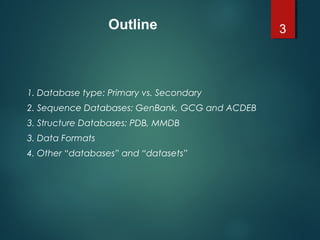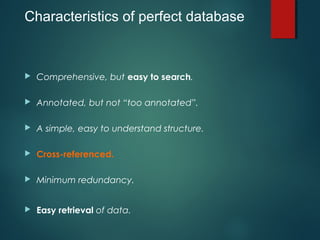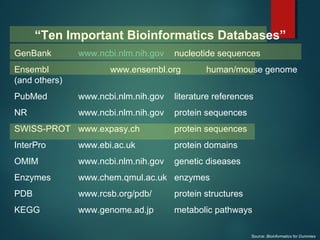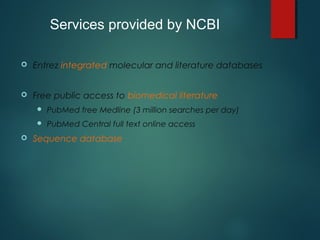Intro to databases
- 2. Able to recognize various data formats, and their primary use Understand and utilize all types of sequence identifiers Understand various feature present in the GenBank flat files and other Databases 2 Objectives
- 3. 1. Database type: Primary vs. Secondary 2. Sequence Databases: GenBank, GCG and ACDEB 3. Structure Databases: PDB, MMDB 3. Data Formats 4. Other “databases” and “datasets” 3Outline
- 4. Structured collection of information of related data elements Consists of basic units called records or entries. Each record consists of fields, which hold pre-defined data related to the record. What are databases ??
- 5. Tables (entities) •basic elements of information to track, e.g., gene, organism, sequence, citation Columns (fields) •attributes of tables, e.g. for citation table, title, journal, volume, author Rows (records) •actual data •whereas fields describe what data is stored, the rows of a table are where the actual data is stored Databases
- 6. 6 Information system Query system Storage System Data GenBank flat file PDB file Interaction Record Title of a book Book Structural organization of data base
- 7. Characteristics of perfect database Comprehensive, but easy to search. Annotated, but not “too annotated”. A simple, easy to understand structure. Cross-referenced. Minimum redundancy. Easy retrieval of data.
- 8. Primary Databases Original submissions by experimentalists Content controlled by the submitter Examples: GenBank, EMBL, DDBJ etc Derivative Databases Derived from primary data Content controlled by third party (NCBI) Examples: NCBI Protein, Refseq, TPA, RefSNP, GEO datasets, UniGene, Homologene, Structure, Conserved Domain Divisions of biological databases
- 9. GenBankGenBank SequencingSequencing CentersCenters GA GAGA ATT ATT C CGAGA ATT ATT C C AT GAGA ATT C C GAGA ATT C C TTGACA ATTGACTA ACGTGC TTGACA CGTGA ATTGACTA TATAGCCG ACGTGC ACGTGC ACGTGC TTGACA TTGACA CGTGA CGTGA CGTGA ATTGACTA ATTGACTA ATTGACTA ATTGACTA TATAGCCG TATAGCCGTATAGCCG TATAGCCGTATAGCCG TATAGCCGTATAGCCG TATAGCCG CATT GAGA ATT C C GAGA ATT C C LabsLabs AlgorithmsAlgorithms UniGene CuratorsCurators RefSeq Genome Assembly TATAGCCG AGCTCCGATA CCGATGACAA Updated continually by NCBI Updated continually by NCBI Updated ONLY by submitters Primary vs. Secondary sequence databases
- 10. “Ten Important Bioinformatics Databases” GenBank www.ncbi.nlm.nih.gov nucleotide sequences Ensembl www.ensembl.org human/mouse genome (and others) PubMed www.ncbi.nlm.nih.gov literature references NR www.ncbi.nlm.nih.gov protein sequences SWISS-PROT www.expasy.ch protein sequences InterPro www.ebi.ac.uk protein domains OMIM www.ncbi.nlm.nih.gov genetic diseases Enzymes www.chem.qmul.ac.uk enzymes PDB www.rcsb.org/pdb/ protein structures KEGG www.genome.ad.jp metabolic pathways Source: Bioinformatics for Dummies
- 11. The National Center for Biotechnology Information Created in 1988 as a part of the National Library of Medicine at NIH – Establish public databases – Research in computational biology – Develop software tools for sequence analysis – Collection and distribution of biomedical information Bethesda,MD
- 12. NCBI (National Center for Biotechnology Information) • over 30 databases including GenBank, PubMed, OMIM, and GEO • Access all NCBI resources via Entrez (www.ncbi.nlm.nih.gov/Entrez/)
- 13. Entrez integrated molecular and literature databases Free public access to biomedical literature PubMed free Medline (3 million searches per day) PubMed Central full text online access Sequence database Services provided by NCBI
- 14. ENTREZ: A DISCOVERY SYSTEM Gene Taxonomy PubMed abstracts Nucleotide sequences Protein sequences 3-D Structure 3 -D Structure Word weight VAST BLASTBLAST Phylogeny Hard Link Neighbors Related Sequences Neighbors Related Sequences BLink Domains Neighbors Related Structures Pre-computed and pre-compiled data. •A potential “gold mine” of undiscovered relationships. •Used less than expected. Pre-computed and pre-compiled data. •A potential “gold mine” of undiscovered relationships. •Used less than expected.
- 22. Primary GenBank: NCBI’s primary sequence database Trace Archive: reads from capillary sequencers Sequence Read Archive: next generation data Derivative GenPept (GenBank translations) Outside Protein (UniProt—Swiss-Prot, PDB) NCBI Reference Sequences (RefSeq) Sequence Database at NCBI
- 23. Nucleotide only sequence database Archival in nature Historical Reflective of submitter point of view (subjective) Redundant Data Direct submissions (traditional records) Batch submissions FTP accounts (genome data) Genbank: Primary Sequence Database
- 24. Three collaborating databases for Nucleotides 1. GenBank 2. DNA Database of Japan (DDBJ) 3. European Molecular Biology Laboratory (EMBL) Database Genbank: Primary Sequence Database
- 26. In GenBank, records are grouped for various reasons: understand this is key to using and fully taking advantage of this database. 26 Guiding principle of GenBank You need identifiers which are stable through time Need identifiers which will always refer to specific sequences Need these identifiers to track history of sequence updates Also need feature and annotation identifiers Identifier
- 27. LOCUS, Accession, NID and protein_id27 LOCUS: Unique string of 10 letters and numbers in the database. Not maintained amongst databases, and is therefore a poor sequence identifier. ACCESSION: A unique identifier to that record, citable entity; does not change when record is updated. A good record identifier, ideal for citation in publication. VERSION: : New system where the accession and version play the same function as the accession and gi number. Nucleotide gi: Geninfo identifier (gi), a unique integer which will change every time the sequence changes. PID: Protein Identifier: g, e or d prefix to gi number. Can have one or two on one CDS. Protein gi: Geninfo identifier (gi), a unique integer which will change every time the sequence changes. protein_id: Identifier which has the same structure and function as the nucleotide Accession.version numbers, but slightlt different format.
- 28. LOCUS, Accession, gi and PID28 Accession.version LOCUS HSU40282 1789 bp mRNA PRI 21-MAY-1998 DEFINITION Homo sapiens integrin-linked kinase (ILK) mRNA, complete cds. ACCESSION U40282 VERSION U40282.1 GI:3150001 CDS 157..1515 /gene="ILK" /note="protein serine/threonine kinase" /codon_start=1 /product="integrin-linked kinase" /protein_id="AAC16892.1" /db_xref="PID:g3150002" /db_xref="GI:3150002" LOCUS: HSU40282 ACCESSION: U40282 VERSION: U40282.1 GI: 3150001 PID: g3150002 Protein gi: 3150002 protein_id: AAC16892.1 Protein_idprotein gi ACCESSION LOCUS PIDgi
- 29. Traditional GenBank Record ACCESSION U07418 VERSION U07418.1 GI:466461 ACCESSION U07418 VERSION U07418.1 GI:466461 Accession •Stable •Reportable •Universal Accession •Stable •Reportable •Universal Version Tracks changes in sequence Version Tracks changes in sequence GI number NCBI internal use GI number NCBI internal use well annotatedwell annotated the sequence is the datathe sequence is the data
- 30. GCG Package (Genetics computer group)
- 31. What is GCG (Genetics Computer Group) An integrated package of over 130 programs (the GCG Wisconsin Package). For extensive analyses of nucleic acid and protein sequences. Associated with most major public nucleic acid and protein databases. Works on UNIX OS and Windows.
- 32. Why use GCG Removes the need for the constant collection of new software by end users. Removes the need to learn new interface as new software is released. Provides a flow of analyses within a single interface. Unix environment allows users to automate complex, repetitive tasks. Allows users to use multiple processors to accelerate their jobs. Supports almost all public databases that can be updated daily. Fast local search.
- 33. Interfaces Command Line: Running programs from UNIX system prompt. SeqLab: Graphic User’s Interface, requiring an X windows display. SeqWeb: to a core set of sequence analysis program.
- 34. Limitations with GCG The GUI interface does not give the users the full access to the power of the command line, nor to the complete set of programs. Many programs place a limit of the maximum size of the sequences that they can handle (350 Kb). This limitation will be removed in version 11.
- 35. Databases GCG Supports Nucleic acid databases GenBank EMBL (abridged) Protein databases NRL_3D UniProt (SWISS-PROT, PIR, TrEMBL) PROSITE, Pfam, Restriction Enzymes (REBASE)
- 36. Typical program
- 37. Result from MAP analysis
- 39. Protein Data Bank (PDB)
- 40. Protein Data Bank (PDB) total yearly
- 41. Protein Data Bank (PDB)
- 42. PDB HEADER COMPND SOURCE AUTHOR DATE JRNL REMARK SECRES ATOM COORDINATES 42 HEADER LEUCINE ZIPPER 15-JUL-93 1DGC 1DGC 2 COMPND GCN4 LEUCINE ZIPPER COMPLEXED WITH SPECIFIC 1DGC 3 COMPND 2 ATF/CREB SITE DNA 1DGC 4 SOURCE GCN4: YEAST (SACCHAROMYCES CEREVISIAE); DNA: SYNTHETIC 1DGC 5 AUTHOR T.J.RICHMOND 1DGC 6 REVDAT 1 22-JUN-94 1DGC 0 1DGC 7 JRNL AUTH P.KONIG,T.J.RICHMOND 1DGC 8 JRNL TITL THE X-RAY STRUCTURE OF THE GCN4-BZIP BOUND TO 1DGC 9 JRNL TITL 2 ATF/CREB SITE DNA SHOWS THE COMPLEX DEPENDS ON DNA 1DGC 10 JRNL TITL 3 FLEXIBILITY 1DGC 11 JRNL REF J.MOL.BIOL. V. 233 139 1993 1DGC 12 JRNL REFN ASTM JMOBAK UK ISSN 0022-2836 0070 1DGC 13 REMARK 1 1DGC 14 REMARK 2 1DGC 15 REMARK 2 RESOLUTION. 3.0 ANGSTROMS. 1DGC 16 REMARK 3 1DGC 17 REMARK 3 REFINEMENT. 1DGC 18 REMARK 3 PROGRAM X-PLOR 1DGC 19 REMARK 3 AUTHORS BRUNGER 1DGC 20 REMARK 3 R VALUE 0.216 1DGC 21 REMARK 3 RMSD BOND DISTANCES 0.020 ANGSTROMS 1DGC 22 REMARK 3 RMSD BOND ANGLES 3.86 DEGREES 1DGC 23 REMARK 3 1DGC 24 REMARK 3 NUMBER OF REFLECTIONS 3296 1DGC 25 REMARK 3 RESOLUTION RANGE 10.0 - 3.0 ANGSTROMS 1DGC 26 REMARK 3 DATA CUTOFF 3.0 SIGMA(F) 1DGC 27 REMARK 3 PERCENT COMPLETION 98.2 1DGC 28 REMARK 3 1DGC 29 REMARK 3 NUMBER OF PROTEIN ATOMS 456 1DGC 30 REMARK 3 NUMBER OF NUCLEIC ACID ATOMS 386 1DGC 31 REMARK 4 1DGC 32 REMARK 4 GCN4: TRANSCRIPTIONAL ACTIVATOR OF GENES ENCODING FOR AMINO 1DGC 33 REMARK 4 ACID BIOSYNTHETIC ENZYMES. 1DGC 34 REMARK 5 1DGC 35 REMARK 5 AMINO ACIDS NUMBERING (RESIDUE NUMBER) CORRESPONDS TO THE 1DGC 36 REMARK 5 281 AMINO ACIDS OF INTACT GCN4. 1DGC 37 REMARK 6 1DGC 38 REMARK 6 BZIP SEQUENCE 220 - 281 USED FOR CRYSTALLIZATION. 1DGC 39 REMARK 7 1DGC 40 REMARK 7 MODEL FROM AMINO ACIDS 227 - 281 SINCE AMINO ACIDS 220 - 1DGC 41 REMARK 7 226 ARE NOT WELL ORDERED. 1DGC 42 REMARK 8 1DGC 43 REMARK 8 RESIDUE NUMBERING OF NUCLEOTIDES: 1DGC 44 REMARK 8 5' T G G A G A T G A C G T C A T C T C C 1DGC 45 REMARK 8 -10 -9 -8 -7 -6 -5 -4 -3 -2 -1 1 2 3 4 5 6 7 8 9 1DGC 46 REMARK 9 1DGC 47 REMARK 9 THE ASYMMETRIC UNIT CONTAINS ONE HALF OF PROTEIN/DNA 1DGC 48 REMARK 9 COMPLEX PER ASYMMETRIC UNIT. 1DGC 49 REMARK 10 1DGC 50 REMARK 10 MOLECULAR DYAD AXIS OF PROTEIN DIMER AND PALINDROMIC HALF 1DGC 51 REMARK 10 SITES OF THE DNA COINCIDES WITH CRYSTALLOGRAPHIC TWO-FOLD 1DGC 52 REMARK 10 AXIS. THE FULL PROTEIN/DNA COMPLEX CAN BE OBTAINED BY 1DGC 53 REMARK 10 APPLYING THE FOLLOWING TRANSFORMATION MATRIX AND 1DGC 54 REMARK 10 TRANSLATION VECTOR TO THE COORDINATES X Y Z: 1DGC 55 REMARK 10 1DGC 56 REMARK 10 0 -1 0 X 117.32 X SYMM 1DGC 57 REMARK 10 -1 0 0 Y + 117.32 = Y SYMM 1DGC 58 REMARK 10 0 0 -1 Z 43.33 Z SYMM 1DGC 59 SEQRES 1 A 62 ILE VAL PRO GLU SER SER ASP PRO ALA ALA LEU LYS ARG 1DGC 60 SEQRES 2 A 62 ALA ARG ASN THR GLU ALA ALA ARG ARG SER ARG ALA ARG 1DGC 61 SEQRES 3 A 62 LYS LEU GLN ARG MET LYS GLN LEU GLU ASP LYS VAL GLU 1DGC 62 SEQRES 4 A 62 GLU LEU LEU SER LYS ASN TYR HIS LEU GLU ASN GLU VAL 1DGC 63 SEQRES 5 A 62 ALA ARG LEU LYS LYS LEU VAL GLY GLU ARG 1DGC 64 SEQRES 1 B 19 T G G A G A T G A C G T C 1DGC 65 SEQRES 2 B 19 A T C T C C 1DGC 66 HELIX 1 A ALA A 228 LYS A 276 1 1DGC 67 CRYST1 58.660 58.660 86.660 90.00 90.00 90.00 P 41 21 2 8 1DGC 68 ORIGX1 1.000000 0.000000 0.000000 0.00000 1DGC 69 ORIGX2 0.000000 1.000000 0.000000 0.00000 1DGC 70 ORIGX3 0.000000 0.000000 1.000000 0.00000 1DGC 71 SCALE1 0.017047 0.000000 0.000000 0.00000 1DGC 72 SCALE2 0.000000 0.017047 0.000000 0.00000 1DGC 73 SCALE3 0.000000 0.000000 0.011539 0.00000 1DGC 74 ATOM 1 N PRO A 227 35.313 108.011 15.140 1.00 38.94 1DGC 75 ATOM 2 CA PRO A 227 34.172 107.658 15.972 1.00 39.82 1DGC 76 ATOM 842 C5 C B 9 57.692 100.286 22.744 1.00 29.82 1DGC 916 ATOM 843 C6 C B 9 58.128 100.193 21.465 1.00 30.63 1DGC 917 TER 844 C B 9 1DGC 918 MASTER 46 0 0 1 0 0 0 6 842 2 0 7 1DGC 919 END 1DGC 920
Editor's Notes
- #3: Francis Ouellette August 3rd, 1999 Lecture 2.0
- #9: Primary databases serve as a repository of experimentalist sequences (GenBank). Derivative databases are sources of edited/curated sequences (RefSeq…reference sequences, UniGene...genes compared to genetic loci on genomes)
- #10: ~11,000 sequences are submitted per day.
- #27: Francis Ouellette August 3rd, 1999 Lecture 2.0
- #28: Francis Ouellette August 3rd, 1999 Lecture 2.0
- #29: Francis Ouellette August 3rd, 1999 Lecture 2.0










































